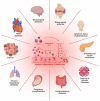Periodontal Inflammation and Systemic Diseases: An Overview
- PMID: 34776994
- PMCID: PMC8578868
- DOI: 10.3389/fphys.2021.709438
Periodontal Inflammation and Systemic Diseases: An Overview
Abstract
Periodontitis is a common inflammatory disease of infectious origins that often evolves into a chronic condition. Aside from its importance as a stomatologic ailment, chronic periodontitis has gained relevance since it has been shown that it can develop into a systemic condition characterized by unresolved hyper-inflammation, disruption of the innate and adaptive immune system, dysbiosis of the oral, gut and other location's microbiota and other system-wide alterations that may cause, coexist or aggravate other health issues associated to elevated morbi-mortality. The relationships between the infectious, immune, inflammatory, and systemic features of periodontitis and its many related diseases are far from being fully understood and are indeed still debated. However, to date, a large body of evidence on the different biological, clinical, and policy-enabling sources of information, is available. The aim of the present work is to summarize many of these sources of information and contextualize them under a systemic inflammation framework that may set the basis to an integral vision, useful for basic, clinical, and therapeutic goals.
Keywords: chronic inflammation; cytokines; molecular mechanisms; oral pathogens; periodontitis; systemic diseases; systemic inflammation.
Copyright © 2021 Martínez-García and Hernández-Lemus.
Conflict of interest statement
The authors declare that the research was conducted in the absence of any commercial or financial relationships that could be construed as a potential conflict of interest.
Figures



References
-
- Acharya A. B., Shetty I. P., Jain S., Padakannaya I., Acharya S., Shettar L., et al. . (2019). Neutrophil-to-lymphocyte ratio and platelet-to-lymphocyte ratio in chronic periodontitis before and after nonsurgical therapy. J. Indian Soc. Periodontol. 23:419. 10.4103/jisp.jisp_622_18 - DOI - PMC - PubMed
-
- Akinkugbe A., Avery C., Barritt A., Cole S., Lerch M., Mayerle J., et al. . (2017). Do genetic markers of inflammation modify the relationship between periodontitis and nonalcoholic fatty liver disease? Findings from the ship study. J. Dent. Res. 96, 1392–1399. 10.1177/0022034517720924 - DOI - PMC - PubMed
Publication types
LinkOut - more resources
Full Text Sources
Other Literature Sources
Medical

